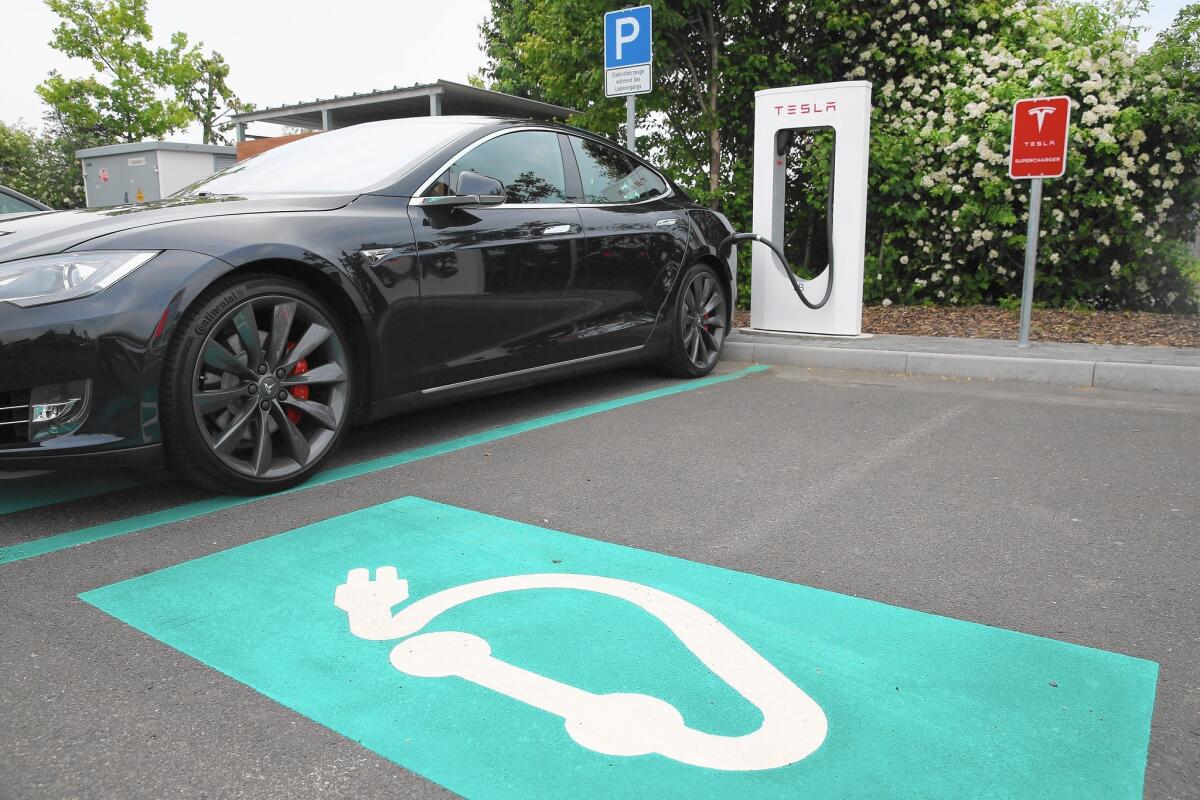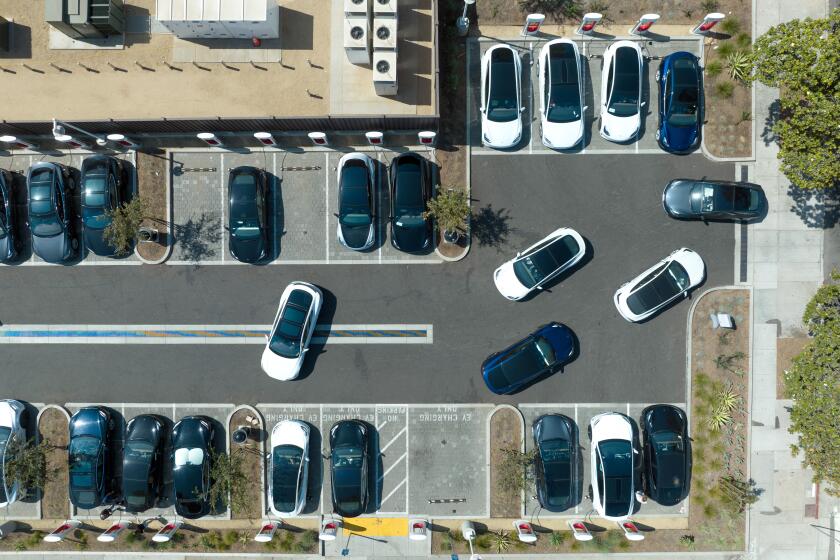Tesla’s push for tougher emission standards would boost its bottom line

A Tesla executive said the company’s goal is to create a mass market for electric vehicles, “where 100% of the transportation in the U.S. and the world is electric.” Above, a sedan is charged in Germany.
- Share via
Tesla Motors Inc. is pushing for tougher auto-emission regulations even as major carmakers are launching initiatives to water down state and federal mandates to increase fuel economy and the number of zero emission vehicles on U.S. roads.
At an industry conference in Michigan, representatives of the Palo Alto electric auto maker said that California will fall far short of an executive order by Gov. Jerry Brown to have 1.5 million electric vehicles on the road by 2025, and that federal fuel economy targets should be higher.
Tesla estimates that manufacturers need to sell only 600,000 zero emission vehicles in California by 2025 based on the current rules, well below Brown’s goal, because of the arcane way the state regulation is written. They will use banked environmental credits to satisfy the rules, reducing the number of vehicles they are obligated to sell.
Tesla has used emissions regulations to its financial advantage. Since 2008, the company has earned more than $534 million from the sale of environmental credits to competitors that don’t sell enough zero emission vehicles to meet California’s rigorous standards — the strictest in the nation. The total also includes sales of federal greenhouse gas credits.
Diarmuid O’Connell, Tesla’s vice president of business development, said Tuesday that although selling credits has been a boon to the company, it isn’t a goal in itself.
“The amount of revenue that we generate from credits has become less strategic over time,” he said.
In the first quarter of this year, Tesla earned $66 million from credit sales, an amount equal to 7% of its $940 million in revenue during the period.
Instead, he said, Tesla’s goal is to create a mass market for electric vehicles, “where 100% of the transportation in the U.S. and the world is electric.”
Tesla’s posture at the conference followed its objection this year to a proposal made to the California Air Resources Board by a group of mid-size automakers, including Mazda, Subaru and Volvo. The car companies asked the board to alter the rules so that they could satisfy their requirements with sales of plug-in hybrids rather than battery-electric and fuel-cell vehicles.
Tesla argued at the time that the state’s zero emission vehicle standards must remain strict.
“With more than 16 million combustion engine vehicles delivered in the United States every year, it is critical that the ZEV standards remain strong and that all automakers are motivated to achieve California’s emissions reduction goals,” James Chen, Tesla’s vice president of regulatory affairs, wrote to the panel in May.
The board sided mostly with the automakers, delaying the requirements to sell zero emission vehicles to 2026 but ordering them to put more plug-in hybrids on the road to comply in the meantime.
California established its Zero Emission Vehicle regulation in 1990 as part of a program to slash air pollution in the state. It allows automakers to generate and bank credits to meet future goals by selling cars with transitional and zero emission technology.
Tesla’s Model S, which can travel up to 270 miles on one charge, earns four credits, and Toyota’s Prius plug-in hybrid, which can go only 11 miles in electric mode before the gas engine kicks in, earns one. Some traditional vehicles, such as the low-polluting Subaru Impreza, earn just two-tenths of a credit.
But so far, U.S. consumers have been slow to adopt alternative fuel technologies, despite those standards and a steadily improving array of low-emission vehicles to choose from.
An analysis by industry research firm WardsAuto found that hybrids, plug-in hybrids and electric vehicles accounted for just 3.6% of U.S. auto sales last year.
“While consumers have more choices than ever in energy-efficient automobiles, if they don’t buy them in large volumes, we fall short,” Mitch Bainwol, chief executive of the Alliance of Automobile Manufacturers, wrote in a recent report. The alliance represents General Motors, Ford, Toyota, Fiat Chrysler Automobiles and other automakers.
O’Connell argued that most automakers haven’t succeeded with electric cars because they build only “compliance cars” — vehicles that meet California’s requirements but fail to trigger consumer emotion.
“I look at these vehicles and I think about toasters,” he said.
A study by the Natural Resources Defense Council supports Tesla’s conclusion that Gov. Brown’s executive order will not be met. But that study is not as pessimistic; it found that at current sales levels there will be nearly 1.3 million plug-in hybrid and zero emission vehicles on California roads by 2025.
In part, that’s because the auto industry has over the years banked at least 168,000 credits by selling a variety of technologies, including electric golf-cart type vehicles, some low emission gasoline cars as well as electric cars and plug-in hybrids, the council said. Still, Tesla has created a brisk market in credits, selling to automakers that either don’t produce electric cars or have made a strategic decision to buy credits and cap their own sales of such vehicles.
The California Air Resources Board has already launched a review of the program, looking at its effectiveness at reducing carbon emissions in the state.
Simon Mui, director of California vehicles and fuels for the Natural Resources Defense Council, said the regulation clearly needs fixes.
“If the state is going to meet the spirit of the law and not just the letter, the program will need to be strengthened and these holes filled,” Mui said. “We need to figure out how to drain the credit bank accounts.”
Tesla is also bucking the industry on another major issue — federal fuel economy standards. Falling oil prices have created a surge in sales of trucks, sport-utility vehicles and crossovers, which made up 54% of U.S. auto sales during the first half of this year, up from 51% a year earlier, according to industry data.
But Tesla doesn’t see a problem with the federal target of 54.5 mpg by 2025. That efficiency goal, measured by special Environmental Protection Agency tests, equals a real-life fuel economy of about 37 mpg.
O’Connell said those standards could “easily” be achieved.
A May analysis by the Union of Concerned Scientists found that the auto industry has made significant strides toward increasing fuel efficiency and is ahead of schedule in meeting the federal fuel economy goals.
Already, 100 models making up 10% of new passenger cars and trucks on the market today meet the federal targets for 2020, the scientists group said.
Twitter: @latimesjerry







